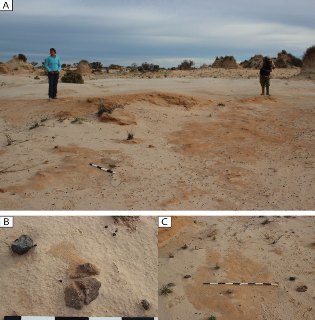Jun 19 2015
Geologists and archaeologists from the Max Planck Institute for Evolutionary Anthropology (Germany), La Trobe University (Australia) and the University of Wollongong (Australia) identify previously unrecognised evidence for a "mega-lake" in the Australian desert 24,000 years ago, at the site of Lake Mungo in south-eastern Australia.
 Archaeological evidence shows that people repeatedly visited an island stranded in the middle of the mega-lake Mungo: A. Baked sediment hearth in the "red lunette" (shoreline dune), B. clay heat retainers, C. close-up of a baked sediment hearth. © William Truscott, La Trobe University
Archaeological evidence shows that people repeatedly visited an island stranded in the middle of the mega-lake Mungo: A. Baked sediment hearth in the "red lunette" (shoreline dune), B. clay heat retainers, C. close-up of a baked sediment hearth. © William Truscott, La Trobe University
This discovery holds significant implications for understanding past climate change. In addition, they present archaeological evidence which shows that people repeatedly visited an island stranded in the middle of the mega-lake. To this aim they likely reinvented boat use and came up with the idea rather quickly.
Lake Mungo, which has been dry for 15,000 years, is the best known basin within the Willandra Lakes World Heritage Area in semi-arid Australia. Its shoreline dune (or “lunette”) preserves Australia’s oldest known human remains and widespread archaeological traces documenting human behavioural change over the last 50,000 years. The sedimentary layers deposited within the lunette provide a comprehensive record of past environmental change over the last 100,000 years. This conjunction of archaeological and sedimentary evidence provides a unique record of interactions between people and their environment through time.
In this study researchers from the Max Planck Institute for Evolutionary Anthropology, La Trobe University and the University of Wollongong identify evidence at Lake Mungo for a previously unrecognised short-lived, very high lake filling event (a “mega-lake”) which took place 24,000 years ago, just prior to the last ice age. Previously it had been assumed that the lakes always filled to the same level. Lake Mungo was assumed to fill repeatedly to the same level from the neighbouring lake. However, this assumption was based on limited early surveying using methods which lacked the precision now available with differential global positioning systems (dGPS).
In the course of their extensive reconnaissance of the lake, the researchers observed an additional line of beach gravels which sits five metres higher than the main shoreline. This was confirmed by dGPS surveys of both the eastern and western shorelines and by sediment analysis of both beach gravels and associated shoreline dune sands. In addition, the researchers undertook luminescence dating of the mega-lake shoreline dune sediments to determine the duration and timing of the event, and a small-scale archaeological survey of the mega-lake shore area. They reconstructed the mega-lake event using a digital elevation model (DEM) and calculated that mega-lake Mungo represented a lake volume increase of 250%. Furthermore, they discovered from the DEM that mega-lake Mungo was linked to the neighbouring lake at two overflow points, creating an island. From their new observations the researchers conclude that this event had substantial implications for past climate: In order for the lake to fill to these levels, the event was most likely caused by a pulse of extremely high rainfall in the catchment at the same time as the climate cooled, just prior to the last ice age. “We know that the last ice age in Australia was cold and dry”, says Kathryn Fitzsimmons of the Max Planck Institute for Evolutionary Anthropology in Leipzig, Germany. “Our results confront previous assumptions and indicate a non-linear transition into the ice age – implying that climate change is not always smooth”.
The dGPS surveys also showed some variations in the elevations both of the main and mega-lake shorelines along the 30 km length of the lake, although the five metre displacement between the two sets of shorelines was consistent. The most likely cause of this anomaly is lake-basin warping by recent tectonic activity. “Australia is often perceived as a tectonically stable continent, and these observations highlight the need to better understand the influence of stresses in the Earth’s crust”, says Fitzsimmons.
The mega-lake, while sudden and short-lived, substantially restricted mobility for people living in the area. Yet archaeological traces on the island, which was cut off from both the western and eastern sides of the lake, indicate that humans rapidly adapted to the new conditions: Stone tools, burnt bones from hearths, and multiple hearth features show that people repeatedly – and intentionally – visited the island, bringing their stone tools with them across the water and exploiting the food resources stranded there. In order to access the island they either swam or used watercraft. Since there is no evidence for watercraft use in Australia between initial colonisation of the continent more than 45,000 years ago, and 6,000 years ago, repeated visits to the island may represent indirect evidence for a resurrection of waterfaring technologies following a pause of at least 20,000 years.
“Our discovery of the mega-lake at Mungo shows that climate and landscapes can change suddenly and dramatically, but also that people seem to adapt pretty quickly to the changing conditions”, says Fitzsimmons. Although the archaeological evidence observed so far was limited to a small-scale survey and does not include boats, the high density of archaeological traces within the sediments associated with the mega-lake is encouraging for future targeted surveys. “Our discovery not only highlights the need to reassess previous assumptions about the nature of climate change, but also suggests that people are more resilient than we’ve previously given them credit for”, says Fitzsimmons.